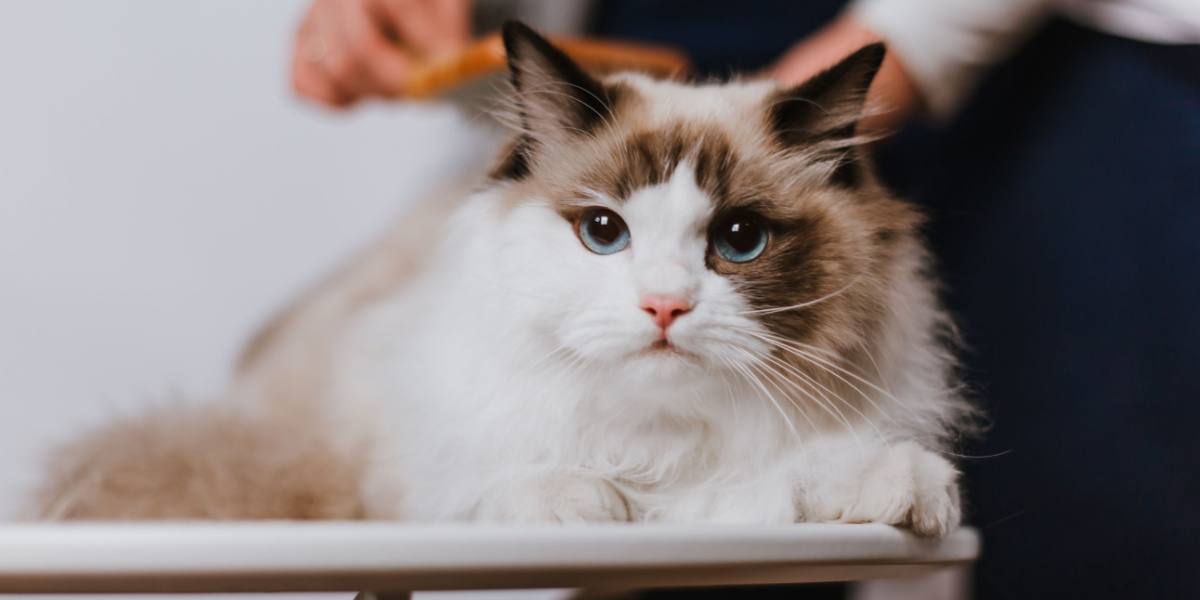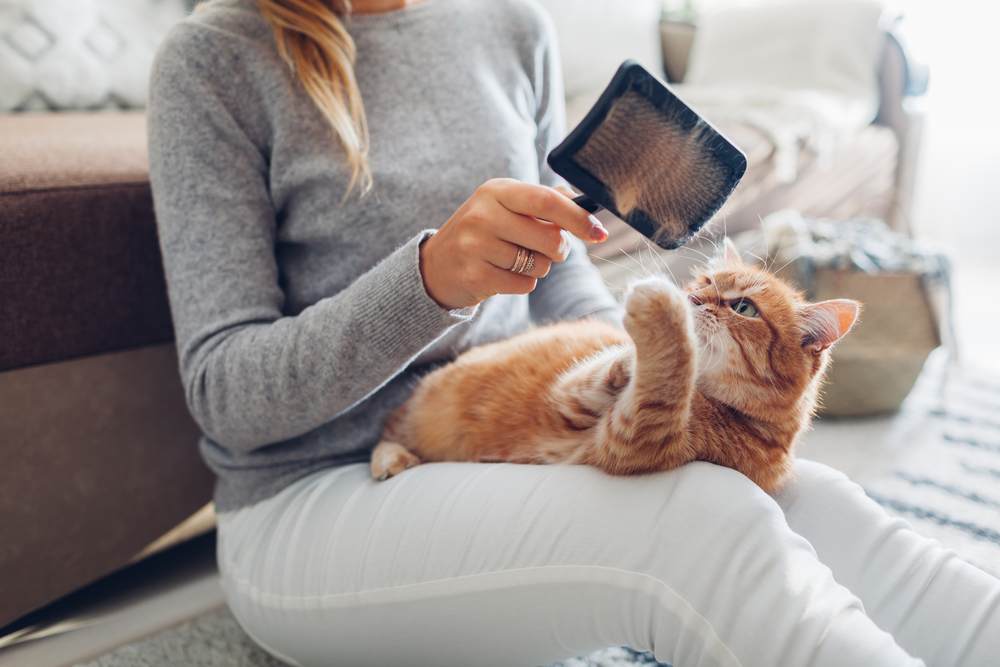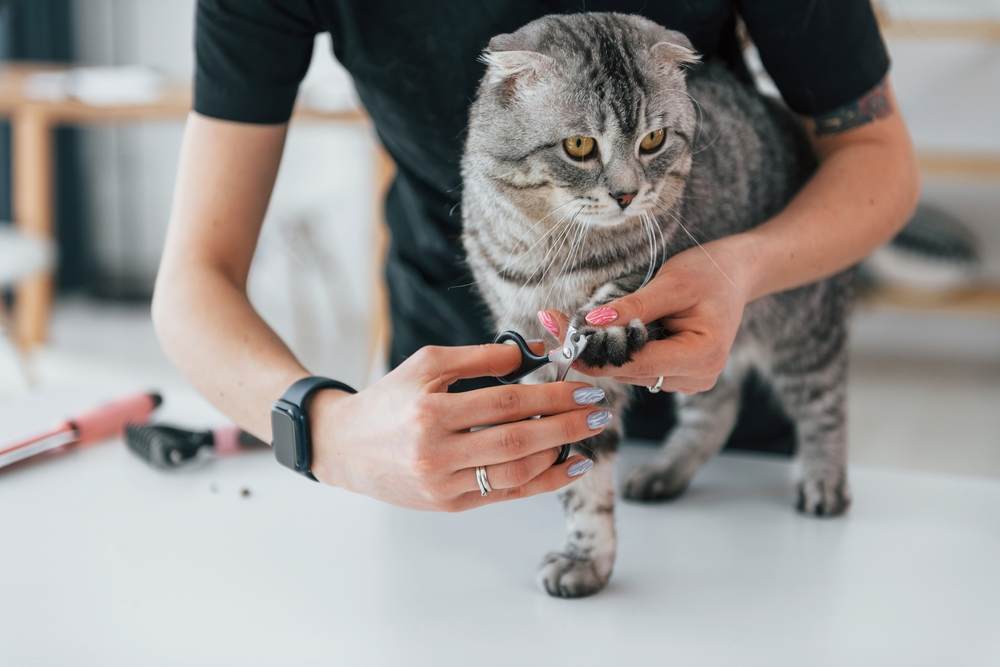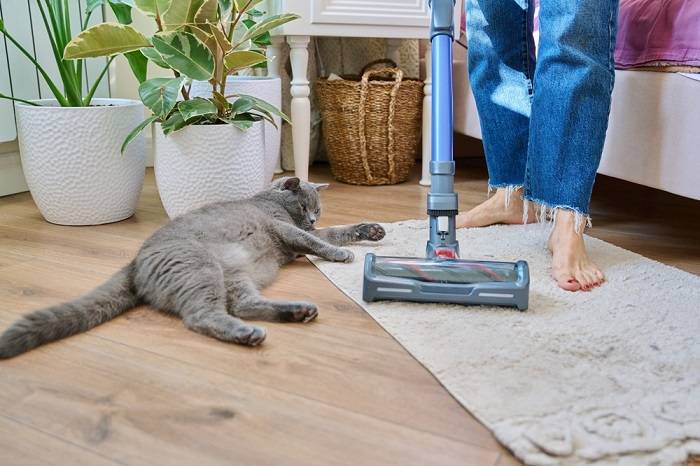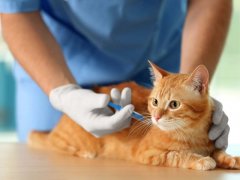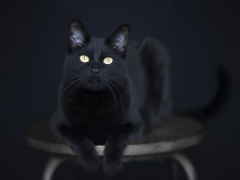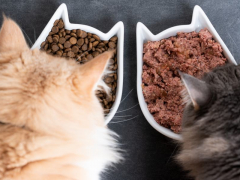While your cat is naturally flexible and well-equipped for grooming themselves with a rough tongue, teeth, and paws, certain things can make it harder for them to keep on top of a grooming routine. One of these is simply being a long-haired kitty.
Grooming is a vital part of being a pet-pawrent to a long-haired cat. It can help prevent mats as well as allow you to bond with your cat. Changes to your cat's fur can give you clues about its health, so it's important to be well acquainted with what's normal. Grooming should encompass not only brushing your cat's coat but giving them a full nose-to-tail check-up and ideally brushing their teeth too!Key Takeaways
Long-haired cat breeds such as Maine Coons, Persians, and Ragdolls, amongst many others, all need a little bit of extra TLC when it comes to coat maintenance. So what can you do to keep on top of your long-haired cat’s grooming needs? We delve into the top 10 tips for those long-haired breeds.
Why Is Grooming Long Haired Cats Important?
Regular grooming sessions can be a positive and rewarding experience for both cat and owner.
Long-haired cats require frequent grooming due to increased matting risk. Daily brushing with a slicker brush prevents tangles, and a mat splitter helps with mats. Combs with wide and narrow teeth, regular trims, and an undercoat rake manage fur. Gentle, patient grooming and professional advice ensure a positive experience.
Cleanliness and Comfort – Each of the hairs that form your cat’s fur coat grows in a cycle that leads to it falling out and then regrowing from the hair follicle. Cats are therefore shedding their hair continuously, although they will tend to have an extensive seasonal shed in the spring and fall months.
Alongside this, dead skin can build up at the base of the hair shaft. Grooming helps remove loose hair and dead skin and spread natural oils across the coat to keep it healthy.
Bonding – When cats groom themselves, it is called autogrooming, but did you know that cats will also groom one another, termed allogrooming? This is a form of social bonding and can be seen between mothers and their kittens but also between cats in the same household. Your cat may even groom you during your snuggle sessions.
Cooling Off – Cats don’t sweat in the same way people do. Wetting their coat with saliva when grooming allows heat to be lost from your cat’s body by evaporation. This is one way your cat can regulate their body temperature.
Health – Regular grooming helps to keep the fur healthy and matt free. It can also help remove parasites, such as fleas or ticks, from within the fur. Regular grooming sessions can also help you pick up on any issues with your pet’s skin or coat early. Excessive or repetitive grooming habits can mark a health or behavioral issue, so if you notice your cat doing this, it is important to speak to your veterinarian for advice.
Grooming Tools for Long Haired Cats
Slicker Brush: Slicker brushes are excellent for removing loose fur and preventing matting in long-haired cats. They have fine, short wires close together.
Comb with Wide and Narrow Teeth: A combination of wide and narrow teeth in a comb is useful for detangling and removing loose hair.
Mat Splitter or Mat Remover: Long-haired cats are prone to matting, and a mat splitter helps gently remove mats without pulling or causing discomfort.
Grooming Scissors or Clippers: Trimming the fur around sensitive areas such as the paws, ears, and sanitary areas may be necessary. A good pair of grooming scissors or clippers can be helpful.
Dematting Tool: These tools are designed to safely remove mats and tangles from your cat’s fur without causing any harm.
Undercoat Rake: Especially important for cats with thick undercoats, an undercoat rake helps to remove loose fur from the underlayer.
Cat Nail Clippers: Regular nail trimming is essential for long-haired cats to prevent discomfort and potential health issues. Choose cat-specific nail clippers for safety.
Grooming Gloves: Grooming gloves with soft rubber tips can be effective in removing loose fur while providing a soothing massage for your cat.
10 Easy Long Haired Cat Grooming Tips Tips
1. Work It Into Your Routine
Work cat grooming into your daily schedule. By allocating just five minutes daily to checking your cat’s coat and giving them a quick brush, you will always be assured to keep on top of their long coat and avoid any tangles or mats developing.
2. Choose the Right Moment
The best time to groom your cat is when they feel comfortable, safe, and relaxed. Observing your cat’s behavior will give you a feel for your kitty’s everyday grooming habits, and you can gradually introduce your grooming activities at this time too.
3. Hone Your Technique
Grooming your cat is more than just giving their fur a quick brush. It is beneficial to give them a quick nose-to-tail check simultaneously. A mental checklist for your grooming sessions can ensure nothing goes unchecked. You should always look in your cat’s ears and mouth and assess their eyes before running your hands over their body to feel for any lumps or bumps.
This will also help you to detect any knots or tangles. The use of treats can make this a fun and pleasant bonding experience for your kitty. It is advisable to get your cat used to the grooming sessions gradually, starting out from when they are a kitten
4. Choose the Best Tool for the Job
When it comes to successfully grooming your cat, it is vital to have the right equipment available. There are many different types of grooming tools on the market, and their suitability depends on the job you are trying to achieve. As a basic grooming kit, you could consider a brush or grooming glove, a comb, scissors, mini hair clippers, and nail clippers.
There are both plastic and metal combs on the market as well as a multitude of brush types. Deciding on the appropriate bristle type or comb style will be impacted both by your cat’s coat and their preference. Speaking to your local pet groomer or veterinarian for advice can be a great starting place when deciding what to buy.
And remember, if you are worried about grooming your cat yourself, you can always consider the use of the services of a professional groomer. There are even mobile groomers that will come to your home, a much more feline-friendly alternative for those that don’t travel well!
5. Look Out for Fur Problems; They Can Mean Health Problems!
Did you know that problems with your cat’s fur can indicate health issues? Changes in your cat’s coat can be a sign of health problems, such as a parasite, bacterial or fungal infections, kidney or hormone issues, arthritis or even associated with stress.
Regular grooming keeps you well in tune with what is normal for your cat. Any changes to coat texture, abnormal self-grooming, hair loss, or skin scabs should warrant a trip to your local veterinarian.
6. Remember the Claws and Teeth!
Owners should check their cat’s nails regularly – ideally once a week.
A problem I often see in the veterinary clinic is one of overgrown claws. Cat’s nails continually grow. It is usually by the process of scratching that cats keep their claws in check. Still, elderly cats or those with mobility issues such as arthritis may struggle with this. You should check on your cat’s claws regularly and trim them as needed. If your cat’s claws become overgrown, they can grow around into the paw pad. This is extremely painful and puts your cat at risk of infection.
Dental disease is a significant cause of pain and discomfort in domesticated cats. It is a myth that cats will go off their food if they have painful teeth. In fact, most cats will continue to eat even with horrific dental disease. As such, working in a quick check of those pearly whites daily can be a vital part of keeping your kitty happy and healthy.
Even better if you can work tooth brushing into your daily grooming schedule! Brushing your cat’s teeth is an effective way to help delay the development of dental disease. Almost all cats will, however, require a professional teeth cleaning, or even tooth extractions, under anesthetic at the veterinary clinic at some point in life. Tooth brushing can, however, reduce the frequency of these procedures.
7. Check Regularly for Mats.
If you own a long-haired cat, you must check them every couple of days, as a minimum, for any evidence of matting. Mats can be highly uncomfortable for your kitty and should be gently removed, either by grooming out if possible or with clippers or scissors if not. If removing a mat with scissors, be extremely careful not to cut your cat’s skin. If matting is severe, this is best removed by a professional groomer or veterinarian to avoid the risk of skin injury.
8. Don’t Ignore Diet
A balanced diet for your cat is vital for their skin and fur health. There are many vitamins and minerals that are required for a healthy fur coat, and these can all be found in high-quality, complete cat food.
Also Read: 15 Best Cat Foods For Shedding
9. Remember to Vacuum!
Long-haired cats often shed a significant amount of hair into their environment.
It may not seem obvious, but keeping on top of the housework can help keep your cat’s coat in tip-top shape. Dead hair around the property can become entangled in your long-haired cat’s coat, making it harder for them to keep on top of grooming themselves and increasing the risk of matting and hairballs. Human hair can also be problematic and contribute to your cat’s fur matting.
10. Lion Cuts
Some cats simply hate to be groomed by their owner and struggle to keep their coats matt free. Additionally, some owners may struggle to keep on top of grooming, especially if they have health issues of their own. Older cats or those suffering from joint pain are those that usually struggle the most with grooming themselves. If your cat is not grooming you can read more advice here.
These long-haired cats can benefit from a “lion cut,” especially in hotter summer months. A lion cut is where the fur is removed from your cat’s body with clippers but left long on the head, legs, and tail. This may seem extreme, but it can be hugely beneficial for the welfare of long-haired cats where grooming is not an option. This should never be attempted with scissors and should ideally be undertaken by a professional groomer.
A full-body clip may need to be done under sedation to reduce the risk of stress for your cat, and if this is the case, it will need to be done at your local vet. If you are struggling to manage your cat’s fur, chat through the options with your veterinarian. A lion cut is not the answer for every long-haired cat but may be appropriate in extreme cases that can’t be managed by conventional grooming means.
Related Articles/ Content
Frequently Asked Questions
Are you supposed to groom long-haired cats?
Yes, in most cases, your long-haired cat will need regular grooming. Long-haired cats can struggle to keep on top of their coat maintenance, leading to mats and tangles.
Are long-haired cats more maintenance?
In short, yes. A cat with longer fur requires more maintenance than their short-haired equivalent. If you are considering purchasing a longer-haired breed, you should be prepared to undertake regular grooming sessions or pay a professional groomer to maintain your cat's luscious locks!
What happens if you don’t groom a long-haired cat?
While most cats are very good at grooming themselves, longer hair cats are more at risk of tangles and mats developing in their fur. If these aren't kept on top of by their owner, they can become dense and closely adhered to the skin, which can be both painful and also damaging to the skin. Poor grooming, sadly, can lead to significant welfare issues in long-haired cats.
